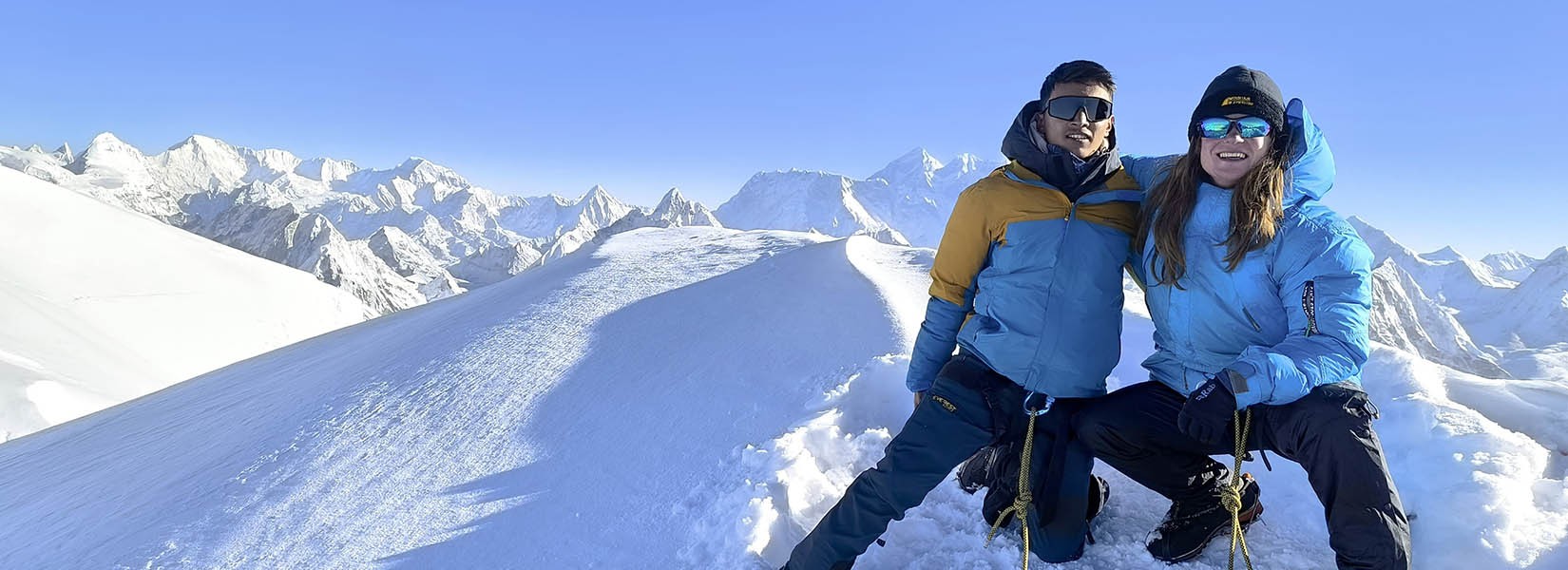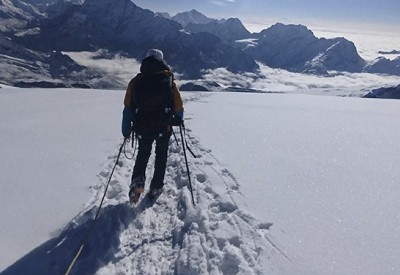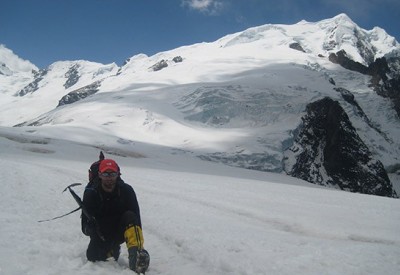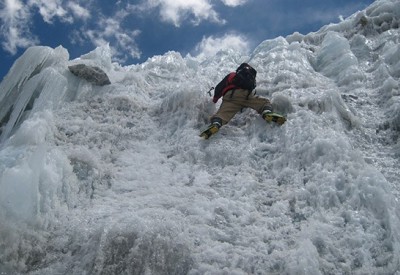Conquer the Himalayas
Nepal, the “Roof of the World”, is the ultimate destination for adventure seekers, mountaineers, and trekkers from around the globe. Home to eight of the fourteen highest mountains on Earth, including the legendary Mount Everest (8,848m / 29,029ft), Nepal offers an unmatched combination of thrilling challenges, breathtaking landscapes, and rich Himalayan culture. Peak climbing in Nepal is more than a physical feat; it’s an immersive journey through some of the most spectacular terrain on the planet, from lush subtropical forests and terraced valleys to rugged alpine meadows and snow-capped summits.
Whether you are an aspiring climber taking your first step on a trekking peak or a seasoned mountaineer targeting one of the technical expedition peaks above 7,000 meters, Nepal caters to every level of adventure. Its peaks range from beginner-friendly trekking peaks like Island Peak and Mera Peak, to challenging expedition climbs such as Ama Dablam and Baruntse. Each peak offers a unique combination of scenic beauty, cultural encounters, and high-altitude thrill, ensuring every expedition is unforgettable.
Why Nepal is the Ideal Peak Climbing Destination
Spectacular Himalayan Views – Nepal’s mountains are world-renowned, and even moderate peaks offer panoramic vistas of Everest, Annapurna, Langtang, Manaslu, and Ganesh Himal. Sunrise and sunset over the towering peaks create once-in-a-lifetime photographic moments.
Diverse Climbing Options – From short, accessible trekking peaks suitable for beginners to high-altitude, technical climbs that challenge the most experienced mountaineers, Nepal provides a wide spectrum of climbing experiences. This makes it perfect for both first-time climbers and seasoned adventurers.
Rich Cultural Experiences – Every climbing route passes through traditional villages, monasteries, and heritage sites, offering intimate encounters with Sherpa, Tamang, Gurung, and other Himalayan communities. Climbers experience not just physical adventure but also a cultural and spiritual journey.
Expert Local Support – Nepal’s peak climbing expeditions are supported by highly trained mountain guides, Sherpas, and support staff. They provide guidance, equipment support, route knowledge, and high-altitude safety, ensuring that climbers can focus on the experience without compromising safety.
Well-Established Infrastructure – Despite its rugged terrain, Nepal offers reliable lodges, tea houses, base camp facilities, and trekking support services. International standard equipment rental, logistics, and emergency evacuation services are readily available.
Year-Round Opportunities – The country offers climbing windows nearly all year, with pre-monsoon (March–May) and post-monsoon (September–November) seasons being the most popular for clear skies and stable weather. Some peaks can even be attempted in winter by highly experienced climbers, while monsoon treks provide lush landscapes and fewer crowds.
The Experience of Peak Climbing
Climbing a Himalayan peak in Nepal is not just a physical endeavor; it is an adventure of the mind and spirit. Each day involves trekking through forests, rivers, and high passes, with stunning vistas revealing themselves around every bend. Base camps provide opportunities to learn technical skills, acclimatize, and enjoy local hospitality. Higher camps challenge climbers with snow, glaciers, and steep ridges, culminating in the unforgettable feeling of standing on a summit surrounded by the world’s tallest mountains.
Peak climbing in Nepal also builds mental resilience, endurance, and confidence. Climbers witness the power and serenity of nature firsthand, often leaving with a profound sense of achievement and connection to the mountains. For many, reaching the summit is a lifelong dream, and Nepal is the perfect stage to turn that dream into reality.
Who Can Climb Peaks in Nepal?
Beginner Trekkers: Trekking peaks under 6,500m like Island Peak, Mera Peak, or Yala Peak are suitable for those new to high-altitude climbing.
Intermediate Climbers: Those with trekking experience can attempt peaks like Lobuche East, Pisang Peak, or Chulu East, combining technical elements with high-altitude trekking.
Experienced Mountaineers: Technical expedition peaks above 7,000m, including Ama Dablam, Baruntse, and peaks in the Manaslu or Everest regions, require advanced climbing skills, physical fitness, and prior experience.
Why Choose Nepal for Your Peak Climbing Adventure?
Unrivaled Himalayan scenery
Opportunities for both trekking and technical climbing
Culturally rich villages and monasteries along the trails
Professional guides, porters, and logistical support
A variety of peaks catering to different skill levels and ambitions
Safe and organized mountaineering infrastructure
Nepal offers a peak climbing experience like no other, combining the thrill of adventure with spiritual and cultural immersion, all set against the backdrop of some of the most awe-inspiring mountains on Earth. Whether you aim for your first trekking peak or a high-altitude expedition, Nepal promises an unforgettable journey to the top of the world.
Perfect! Here’s an extended, SEO-friendly, comprehensive peak comparison table for Nepal, including technical requirements, base camp altitude, and ideal starting points. This is designed for climbers to make informed decisions and for your landing page to rank high for keywords like “peak climbing Nepal” and “Himalayan mountaineering.”
Comprehensive Peak Climbing Guide – Nepal
| Peak Name | Altitude (m / ft) | Difficulty | Region | Base Camp Altitude (m / ft) | Technical Requirements | Typical Duration | Ideal Start Point | Best Season |
|---|---|---|---|---|---|---|---|---|
| Island Peak (Imja Tse) | 6,189 m / 20,305 ft | Moderate | Everest | 5,087 m / 16,690 ft | Basic ice climbing, crampons | 12–14 days | Lukla | Mar–May / Sep–Nov |
| Mera Peak | 6,476 m / 21,247 ft | Moderate | Everest | 5,415 m / 17,756 ft | Glacier travel, ice climbing | 14 days | Lukla | Mar–May / Sep–Nov |
| Lobuche East | 6,119 m / 20,075 ft | Moderate | Everest | 4,910 m / 16,100 ft | Crampon and basic ice climbing | 12–14 days | Lukla | Mar–May / Sep–Nov |
| Yala Peak | 5,500 m / 18,045 ft | Easy | Langtang | 4,500 m / 14,764 ft | Simple glacier climb | 7–8 days | Syabrubesi | Mar–May / Sep–Nov |
| Pisang Peak | 6,091 m / 19,980 ft | Moderate | Annapurna | 5,100 m / 16,732 ft | Ice and snow climbing | 12 days | Manang | Mar–May / Sep–Nov |
| Chulu East | 6,584 m / 21,607 ft | Moderate | Annapurna | 5,200 m / 17,060 ft | Glacier travel, basic ice climbing | 12–14 days | Manang | Mar–May / Sep–Nov |
| Ama Dablam | 6,812 m / 22,349 ft | Hard | Everest | 4,570 m / 14,993 ft | Technical rock & ice climbing | 20+ days | Lukla | Mar–May / Sep–Nov |
| Baruntse | 7,129 m / 23,386 ft | Very Hard | Solu-Khumbu | 5,100 m / 16,732 ft | Technical high-altitude climbing | 25–30 days | Lukla | Mar–May / Sep–Nov |
| Thamserku | 6,623 m / 21,729 ft | Hard | Everest | 4,870 m / 15,978 ft | Technical climbing on rock & snow | 18–20 days | Lukla | Mar–May / Sep–Nov |
| Gokyo Ri (Peak) | 5,357 m / 17,575 ft | Easy-Moderate | Everest | 4,750 m / 15,584 ft | Trekking with light scrambling | 10 days | Lukla | Mar–May / Sep–Nov |



